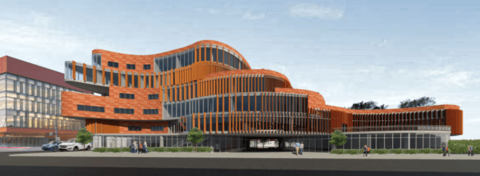Architecture Seniors Christine Griffith and Kyle Martin Receive Honorable Mention at ACSA 2021 Steel Competition

Architecture seniors Christine Griffith and Kyle Martin received an honorable mention for their project titled “The Howard University Center for Inclusive Design” at the Association of Collegiate Schools of Architecture 2021 Steel Competition. Farhana Ferdous, Ph.D., Howard University assistant professor of architecture, served as faculty advisor. The design was recognized for its detail to accessibility and integrated approach for an urban site, taking into consideration the need for ample light and air, as well as sensitivity to human scale.
“By keeping in mind workplace wellnesses in the COVID-19 outbreak, the theme of this project was to design a solution that bridge cultures, conflicts, and challenges faced in our current climate of uncertainty and glaring social inequality,” said Dr. Ferdous.
The Howard University Center for Inclusive Design was designed to bring together the campus community and acts as a gateway between the campus and the broader Georgia Avenue community. Directly affiliated with the Department of Architecture, the center is dedicated to provide community services through design and research, education and consultation, by enhancing the experience of richly diverse members of the Howard community regardless of age, ability, culture, etc. The design concept was to explore ways to enable greater inclusivity, provide more opportunities, and celebrate diversity in workplace environment within an urban context.
“Our aim was to create a structure that not only serves the campus functionally but acts as a symbol that identifies the University,” said Griffith and Martin.
The building’s form was designed to pay homage to the inclusive theme of the building’s function. The center’s curved form is intended to help create a warm and welcoming environment that eliminates the concept of an edge or a more rigid structure. Steel and Terracotta were extensively used as building materials. The terracotta louvers produce a shading effect on the building, reducing the thermal heat gain while ensuring sufficient indoor lighting, preventing glare, reducing energy consumption, controlling humidity and solar radiation, and acting as thermal bridges.
An optimal and healthy environment can improve occupants’ performance and overall health. This environment was achieved by incorporation of design decisions such as multiple outdoor spaces, biophilic design elements, daylighting, sanitation stations, and open and flexible floor plans. These design elements create an inclusive and accessible environment for a better indoor-outdoor experience for the diverse Howard community.
